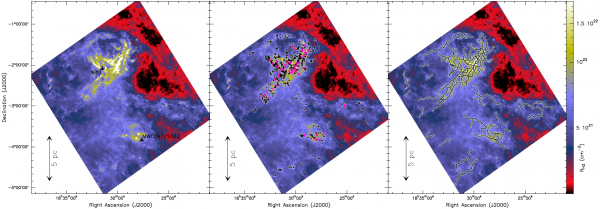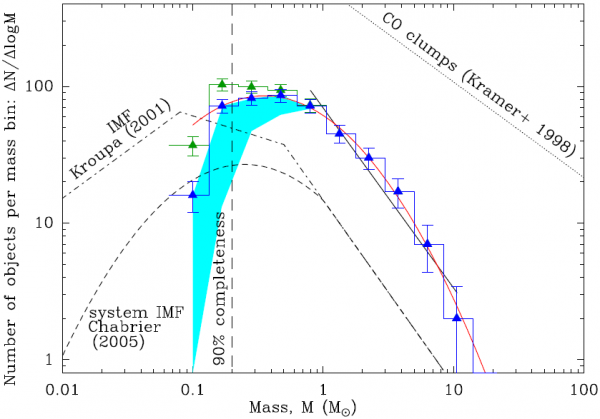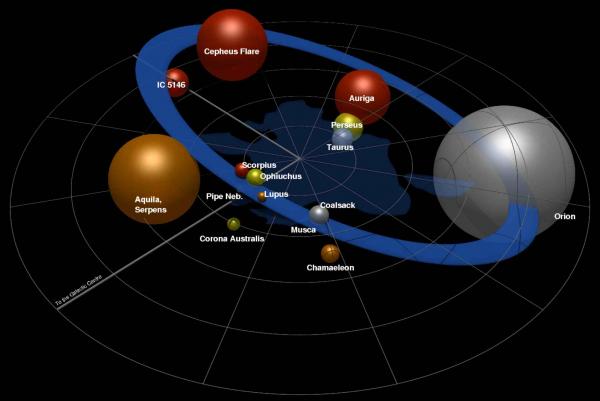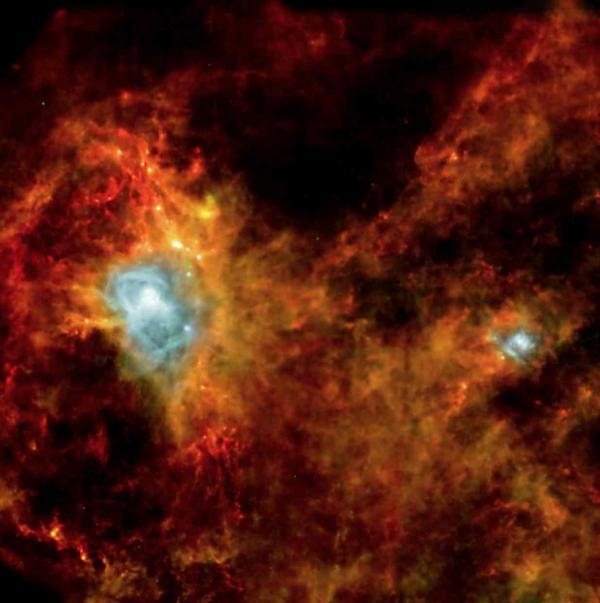Based on observations of nearby molecular clouds with the Herschel space observatory, recently large samples of future stars were detected in the form of dense cores. The properties of these compact seeds and their connection with interstellar filaments reveal us the earliest key stages of stars and the way of low-mass star formation.
Among several cloud complexes along the Gould Belt (see image below) the Aquila and Taurus regions were targeted. While the star formation in Aquila was relatively unexplored until recently, the Taurus cloud with its main filaments is well known. The Aquila Rift lies above the Galactic plane at the distance of about 260 parsec (approximately 850 light-years from the Sun). The Taurus region is more nearby, it seems to sit in the wall of the Local Bubble - a cavity, surrounding the Solar System- at 140 parsec (or 450 light-years) from us.

The Gould Belt (represented by the blue ring) is shown relative to the Galactic plane, with the bright star-forming regions (for e.g., Aquila, Taurus, Orion, etc.) along it up to a 500 parsec distance from the Sun (center of the plane). The Local Bubble is shown as a shaded blue area. The size of the star-forming regions is proportional to their mass, assuming a uniform density. Image credit: J. Kirk (modifications by V. Konyves).
In these two regions, a complete census of dense cores was obtained with Herschel and their properties and spatial distribution discussed. The large-number statistics of several hundreds of cores separately in Aquila and Taurus allowed us to obtain the most meaningful results on the formation of dense cores and their physical properties, such as their temperatures, masses, densities and lifetimes, which was not possible until now.

'Left': H_2 column density map of the Aquila region, derived from Herschel Gould Belt survey data. The black marks show the locations of hot HII regions in the field. 'Middle': 446 prestellar cores (black triangles) and 58 more evolved protostellar cores (magenta triangles) are overplotted, which were extracted from the Herschel PACS (70-160 micron), SPIRE (250-350-500 micron), and column density images. 'Right:' Network of filaments traced in the column density image. The spatial distribution of prestellar cores is strongly correlated with filaments. Figure adapted from Konyves et al. (2015).
One of the primary objectives of the Herschel Gould Belt survey was the study of the distribution of prestellar core masses or "prestellar core mass function". From its comparison to the mass distribution of stars (stellar initial mass function) it was possible to confirm that stellar masses are already determined at the early stages of filament/cloud fragmentation. The spatial distribution of compact prestellar cores is strongly correlated with that of the densest filaments, showing that interstellar filaments are the preferred environment for star formation.

Core mass function (CMF) of 651 starless cores (green histogram), and 446 prestellar cores (blue histogram) in Aquila. The prestellar CMF is approximated with a lognormal fit (red curve) with a peak at around 0.5 solar mass. The high-mass end of the CMF is fitted by a power-law, the slope of which is similar to the famous Salpeter slope. The shaded area in light blue reflects the uncertainties in the prestellar CMF arising from the uncertain classification between gravitationally bound "prestellar" and unbound "starless" objects. For comparison, the initial mass function (IMF) of single stars (e.g.. Kroupa 2001), the IMF of multiple systems (e.g. Chabrier 2005), and the typical mass distribution of CO clumps (Kramer et al. 1998) are also shown. Figure adapted from Konyves et al. (2015).
These Herschel findings support a picture where ubiquitous filaments are believed to precede the onset of star formation. Then, under the influence of local gravitational forces the densest filaments contract and fragment to compact protostellar seeds which are ultimately forming stars in molecular clouds of the Galactic interstellar medium. This filaments-driven scenario provides some new insight into the origin of the quasi-universal star formation law observed on galactic scales.
Contacts: Vera Konyves, Philippe André
Publications :
"A census of dense cores in the Taurus L1495 cloud from the Herschel Gould Belt Survey"
Marsh et al. 2016, (MNRAS 459, 342) - astro-ph/1602.03143
"A census of dense cores in the Aquila cloud complex: SPIRE/PACS observations from the Herschel Gould Belt survey",
V. Konyves et al. 2015 (A&A 584, A91) - astro-ph/1507.05926
"From Filamentary Networks to Dense Cores in Molecular Clouds: Toward a New Paradigm for Star Formation",
Ph. André et al. 2014 (Protostars and Planets VI, 27) - astro-ph/1312.6232
"From filamentary clouds to prestellar cores to the stellar IMF: Initial highlights from the Herschel Gould Belt survey",
Ph. André et al. 2010 (A&A 518, L102) - astro-ph/1005.2618
Links:
The Herschel Gould Belt survey website (http://gouldbelt-herschel.cea.fr)
Images :
Colour-composite image of the Aquila Rift showing the extended filamentary structure of this star-forming cloud.
Three-colour image of the B211/B213 filament in the Taurus Molecular Cloud combining Herschel bands at 160 μm (blue), 250 μm (green) and 500 μm (red). The image spans about 2×5 degrees.
• Structure and evolution of the Universe › Planets, star's formation and dynamics, interstellar medium
• Department of Astrophysics (DAp) // UMR AIM
• Star Formation and Interstellar Medium
• HERSCHEL







